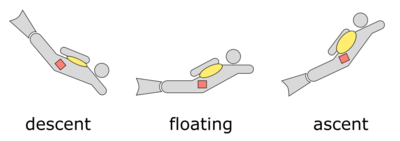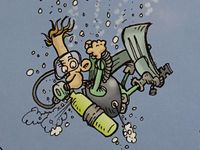Buoyancy control
In dive sport, buoyancy control is the process of balancing the total weight of the diver including equipment by adding or releasing air to/from the buoyancy control device (BCD) and to float weightlessly in the water.
The physical basis for this is the Archimedes' principle.
Contents
Before your first dive
Your diving equipment is configured in such a way that you are slight negative buoyant in the water, meaning without buoyancy control you would sink continuously. To prevent this, your buoyancy control device (BCD) contains a bladder which can be adjusted by adding or removing air using the inflator. If you fill your BCD with air, you get buoyancy and ascend. If you empty it, you sink. Adding just enough air to your BCD to be neutrally buoyant, not sinking or ascending is the art of mastering buoyancy control. This requires a lot of training. During your VIT dive course you will practice this enough and get a feel for the right buoyancy control.
- Warning
Never jump into the water with an empty BCD, otherwise you will sink immediately, but fill your BCD with air on land so you float comfortably while entering the water. Conversely, under water, do not fill your BCD uncontrolled with air, otherwise you will ascend to fast and uncontrolled, risking e. g. decompression sickness.
Basic knowledge for Open Water Diver* (OWD*)
When diving, you can change your weight (i. e. the downforce) mainly by adding or removing lead weights. You change your buoyancy (i. e. the upforce caused by your volume) by the air in your BCD and with your breathing.
You can achieve weightless floatation (hydrostatic balance) by adding the appropriate amount of air by the inflator into the BCD in order to precisely balance the weight of the equipment. The added amount of air increases your volume and makes you more buoyant (see Archimedes' principle). The main control of your buoyancy is achieved by adding or releasing air to or from your BCD. The fine-tuning is done by controlling breathing, because you can change the volume of your lungs by some liters by breathing. Very soon you will realize, that taking a deep breath from your regulator will make you more buoyant and let you ascend. If you exhale very deep, this will make you negatively buoyant and let you sink. However, control your breathing, but never hold your breath!
The ideal state is being neutrally buoyant and float weightless in the water. This way we stay above the seabed, not damaging sensitive marine life. As better we master buoyancy control as more relaxed will be the dive and as less effort you need to move through the water. This also serves for less air consumption. Hence, do not try to use your fins in order to stay at the desired depth but use your BCD.
Influencing factors
Buoyancy control is an ongoing process during the dive, you have to adjust the amount of air in your BCD to stay in hydrostatic balance every time you change your depth. Some of the major factors influencing the desired amount of air:
- Depth: The thickness of your dive suit will vary with depth as neoprene compresses more under higher ambient pressure resulting in less buoyancy.
- Breathing: The air in your lungs gives you also buoyancy. If you breathe deeper, you have more lift, you exhale stronger, you have less lift.
- Air supply in the diving cylinder: The volume of the diving cylinder does not change during the dive, however, the amount of air contained in the tank and therefore it's weight. Therefore, the cylinder has less weight at the end of the dive than in the beginning.
- Lead weight: The more lead weights you carry, the more air you need in your BCD to compensate for its weight.
Amount of lead weights
There is no easy way to calculate the correct amount of weights a diver needs. It is best to determine it by a check dive. The result should then be noted in the logbook indicating the equipment configuration for later dives.
The goal is to be neutrally buoyant at the end of the dive with an almost empty diving cylinder, an empty BCD and with normal breathing at the last deco stop or at the safety stop in 3 m of depth without any movement of the fins. For the beginning of the dive, this means that you should float at eye level on the surface with a full tank, an empty BCD and holding a normal breath. By exhaling, you should start to sink. Since the diving suit is made out of neoprene and therefore loses some of its buoyancy in depth, this accounts for normal breathing in a depth of 3 meters. Since your cylinder will be lighter at the end of the dive due to the consumption of the air (approx. 2 kg for a 10 liter cylinder), you have to check the amount of weights then again.
In addition to buoyancy control it is also important for comfort and ease of movement through the water to lay as horizontal as any possible in the water. You should not tilt forward or backward. For this, the lead weights should sit on your front side. You may use trim weights in the BCD to reach this position. Most better BCDs have special trim weight pockets.
Hints
- If you have problems descending even if you have an adequate amount of weights, do not try to descend with your fins down. With an empty BCD stretch your legs to the back, tilt your upper body slightly forward and breath out. In this position, you prevent yourself from accidentally kicking yourself back up to the surface while moving your fins.
- The slower you swim, the more accurate you'll have to be with your buoyancy control, as poor buoyancy control can then not be compensated by speed. In order to master buoyancy control, you should therefore move very slowly through the water.
- You need to be a little pacient when controlling your buoyancy since the response to adding or releasing air to or from your BCD is slightly delayed. Therefore, always just add or release a little air and wait a moment before adding or releasing more.
- Especially at the beginning or if you dive with some new equipment, keep your inflator always in your hand so you don't have to waste time finding it and you can react in time.
- You can release air from your BCD using the inflator or one of the quick releases. With the inflator you can release the air in small controlled quantities, but it takes longer to empty the BCD than using the quick release. You can controll the amount of dumped air nearly as good as with the inflator by pulling the quick release only in short pulses.
- Air is always going up to the highest possible point. If you want to dump air, you must make sure that the valve (inflator or quick release) is the highest point. You have to raise your upper body and the arm holding your inflator (usually left) and hold the inflator up.
- During descent the volume of the diving suit as well as of the air in the BCD decreases because of the increasing ambient pressure (see Boyle's law). To compensate for the increasing downforce, you have to add air as the depth increases. When ascending, the reverse happens: The volume increases and leads to positive buoyancy. In order not to rise faster and faster, you have to release air frequently on ascend.

